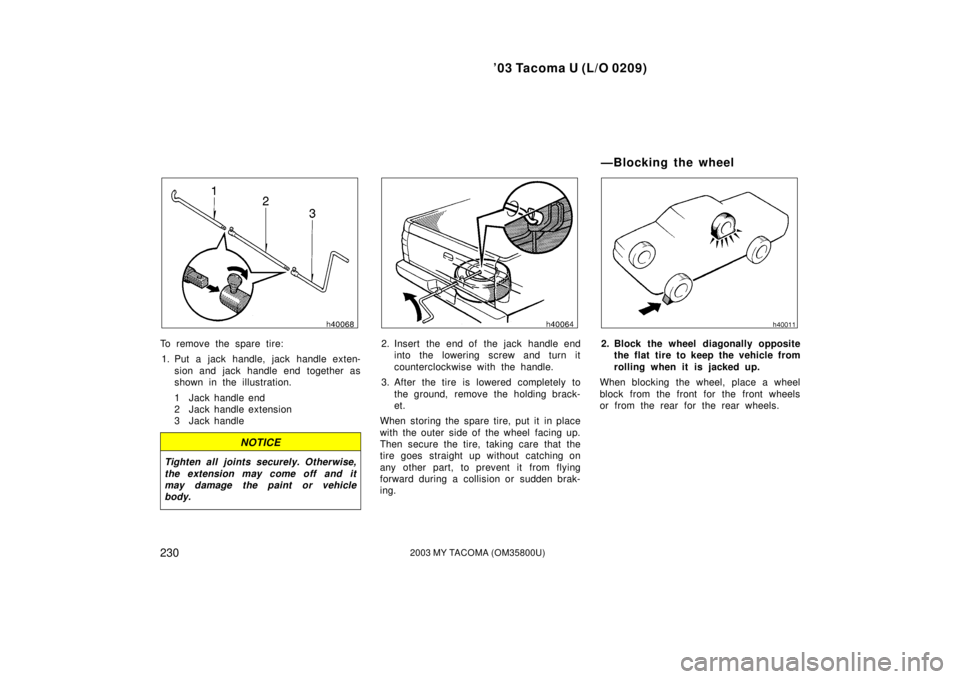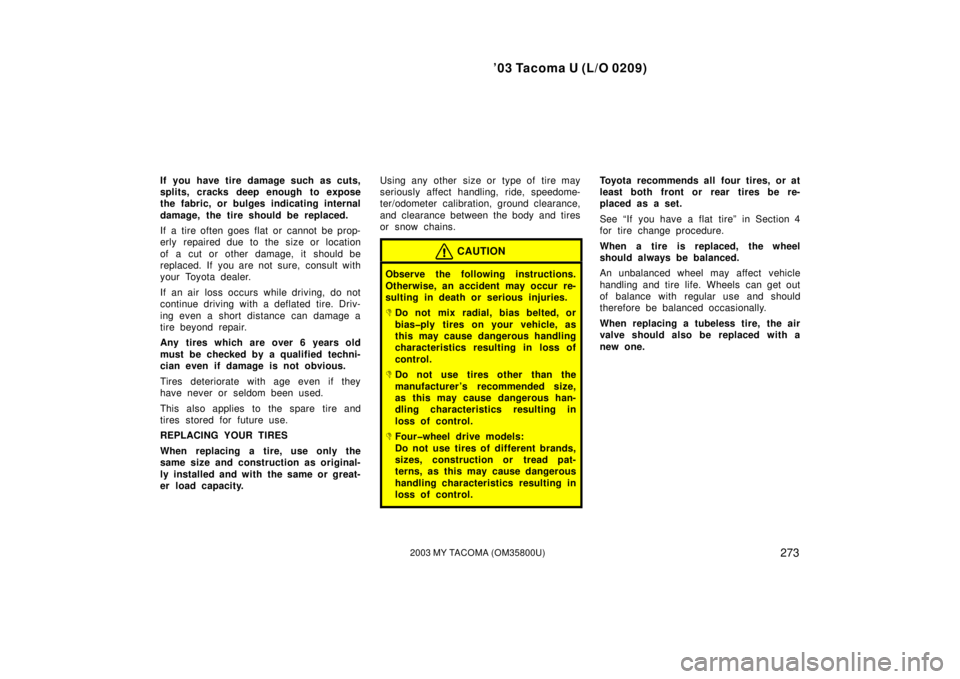Page 234 of 311

’03 Tacoma U (L/O 0209)
2282003 MY TACOMA (OM35800U)
1. Get the required tools and sparetire.
1 Wheel nut wrench
2 Jack handle
3Jack
To prepare yourself for an emergency, you
should fam iliarize yourself with the use of
the jack, each of the tools and their stor-
age locations.
Turn the jack joint by hand.
To remove: Turn the joint in direction 1
until the jack is free.
To store: Turn the joint in direction 2 until
the jack is firmly secured to prevent it
flying forward during a collision or s udden
braking.To remove the spare tire:
1. Insert the end of the jack handle into the lowering screw and turn it counter-
clockwise.
2. After the tire is lowered completely to the ground, remove the holding brack-
et.
When storing the spare tire, put it in place
with the outer side of the wheel facing up.
Then secure the tire, taking care that the
tire goes straight up without catching on
any other part, to prevent it from flying
forward during a collision or s udden brak-
ing.
—Required tools and spare tire
(regular cab models)
Page 236 of 311

’03 Tacoma U (L/O 0209)
2302003 MY TACOMA (OM35800U)
To remove the spare tire:1. Put a jack handle, jack handle exten- sion and jack handle end together as
shown in the illustration.
1 Jack handle end
2 Jack handle extension
3 Jack handle
NOTICE
Tighten all joints securely. Otherwise,
the extension may come off and it
may damage the paint or vehicle
body.
2. Insert the end of the jack handle endinto the lowering screw and turn it
counterclockwise with the handle.
3. After the tire is lowered completely to the ground, remove the holding brack-
et.
When storing the spare tire, put it in place
with the outer side of the wheel facing up.
Then secure the tire, taking care that the
tire goes straight up without catching on
any other part, to prevent it from flying
forward during a collision or s udden brak-
ing.2. Block the wheel diagonally opposite the flat tire to keep the vehicle from
rolling when it is j acked up.
When blocking the wheel, place a wheel
block from the front for the front wheels
or from the rear for the rear wheels.
—Blocking the wheel
Page 240 of 311

’03 Tacoma U (L/O 0209)
2342003 MY TACOMA (OM35800U)
6. After making sure that no one is inthe vehicle, raise it high enough so
that the spare tire can be installed.
Remember you will need more ground
clearance when putting on the spare tire
than when removing the flat tire.
Regular cab models—To raise the vehicle,
insert the jack handle into the jack (it is
a loose fit) and turn it clockwise. As the
jack touches the vehicle and begins to lift,
double�check that it is properly positioned. Xtra�cab and double cab models—To raise
the vehicle, insert the jack handle end
with the extension into the jack (it is a
loose fit) and turn it clockwise with the
handle. As the jack touches the vehicle
and begins to lift, double�check that it is
properly positioned.
CAUTION
Never get under the vehicle when the
vehicle is supported by the jack
alone.
7. Remove the wheel nuts and change
tires.
Lift the flat tire straight off and put it
aside.
Roll the spare wheel into position and
align the holes in the wheel with the bolts.
Then lift up the wheel and get at least the
top bolt started through its hole. Wiggle
the tire and press it back over the other
bolts.
—Raising your vehicle —Changing wheels
Page 279 of 311

’03 Tacoma U (L/O 0209)
2732003 MY TACOMA (OM35800U)
If you have tire damage such as cuts,
splits, cracks deep enough to expose
the fabric, or bulges indicating internal
damage, the tire should be replaced.
If a tire often goes flat or cannot be prop-
erly repaired due to the size or location
of a cut or other damage, it should be
replaced. If you are not sure, consult with
your Toyota dealer.
If an air loss occurs while driving, do not
continue driving with a deflated tire. Driv-
ing even a short distance can damage a
tire beyond repair.
Any tires which are over 6 years old
must be checked by a qualified techni-
cian even if damage is not obvious.
Tires deteriorate with age even if they
have never or seldom been used.
This also applies to the spare tire and
tires stored for future use.
REPLACING YOUR TIRES
When replacing a tire, use only the
same size and construction as original-
ly installed and with the same or great-
er load capacity.Using any other size or type of tire may
seriously affect handling, ride, speedome-
ter/odometer calibration, ground clearance,
and clearance between the body and tires
or snow chains.
CAUTION
Observe the following instructions.
Otherwise, an accident may occur re-
sulting in death or serious injuries.
�Do not mix radial, bias belted, or
bias�ply tires on your vehicle, as
this may cause dangerous handling
characteristics resulting in loss of
control.
�Do not use tires other than the
manufacturer ’s recommended size,
as this may cause dangerous han-
dling characteristics resulting in
loss of control.
�Four�wheel drive models:
Do not use tires of different brands,
sizes, construction or tread pat-
terns, as this may cause dangerous
handling characteristics resulting in
loss of control.
Toyota recommends all four tires, or at
least both front or rear tires be re-
placed as a set.
See “If you have a flat tire” in Section 4
for tire change procedure.
When a tire is replaced, the wheel
should always be balanced.
An unbalanced wheel may affect vehicle
handling and tire life. Wheels can get out
of balance with regular use and should
therefore be balanced occasionally.
When replacing a tubeless tire, the air
valve should also be replaced with a
new one.
Page 280 of 311

’03 Tacoma U (L/O 0209)
2742003 MY TACOMA (OM35800U)
With a spare tire of the same wheel type
as the installed tires
With a spare tire of different wheel type
from the installed tires
To equalize the wear and help extend
tire life, Toyota recommends that you
rotate your tires according to the main-
tenance schedule. (For scheduled main-
tenance information, please refer to the
“Scheduled Maintenance Guide” or
“Owner ’s Manual Supplement”.) Howev-
er, the most appropriate timing for tire
rotation may vary according to your
driving habits and road surface condi-
tions.
See “If you have a flat tire” in Section 4
for tire change procedure.
When rotating tires, check for uneven
wear and damage. Abnormal wear is usu-
ally caused by incorrect tire pressure, im-
proper wheel alignment, out�of�balance
wheels, or severe braking.WHEN TO USE SNOW TIRES OR
CHAINS
Snow tires or chains are recommended
when driving on snow or ice.
On wet or dry roads, conventional tires
provide better traction than snow tires.
SNOW TIRE SELECTION
If you need snow tires, select the same
size, construction and load capacity as
the original tires on your Toyota.
Do not use tires other than those men-
tioned above. Do not install studded tires
without first checking local regulations for
possible restrictions.
CAUTION
Observe the following instructions.
Otherwise, an accident may occur re-
sulting in death or serious injuries.
�Do not use snow tires other than
the manufacturer ’s recommended si-
ze, as this may cause dangerous
handling characteristics resulting in
loss of control.
Rotating tires
Installing snow tires and
chains